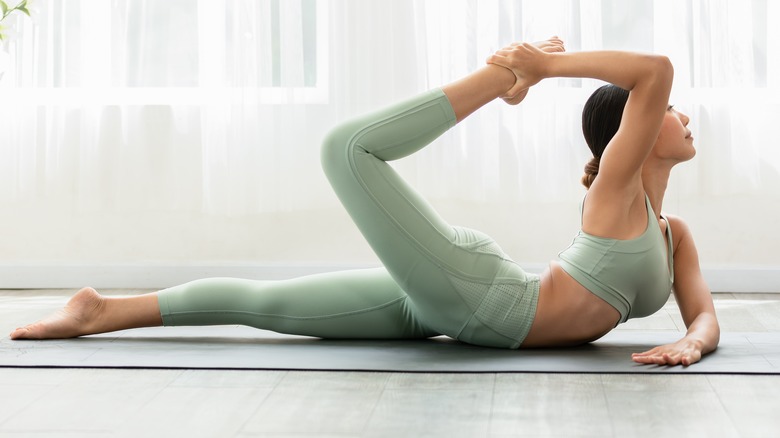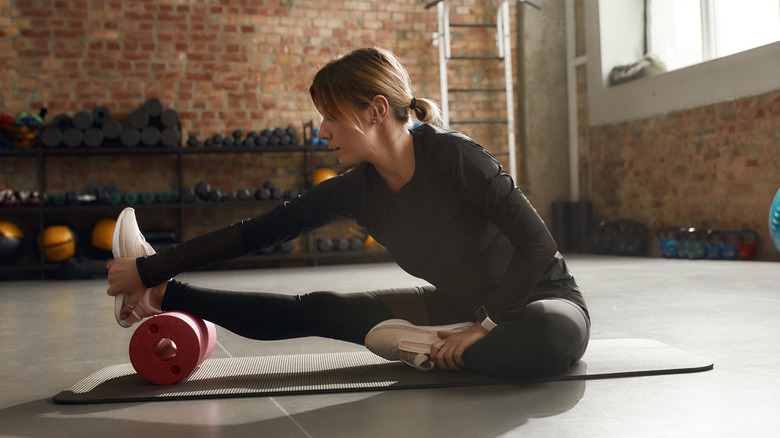What Is Mobility Training And How Can It Help You Have A Safe Workout?
When you think of fitness, you probably think of lifting heavy at the gym or running on a treadmill until you're sweaty and breathless. It's common to assume that unless you're pushing your limits in a workout, you're not doing much. And while there's no denying that difficult exercises centered around cardio and strength training are excellent for your health, there are several benefits you can derive from lower-impact routines too.
Mobility training is one such routine that almost seems like it was made to help us gain some relief from the sedentary lifestyle we've grown accustomed to. Mobility is an important aspect of our overall well-being that we often ignore in our journey toward our fitness goals. It's often used interchangeably with flexibility, but in reality, they're different concepts. Speaking to Women's Health, elite trainer Luke Worthington defined the two terms as: "Flexibility is the range of motion available to a person while mobility is the range they have control over."
Physical therapist David Hastie elaborated further: "You need the flexibility to get into certain positions, like a deep squat, but you wouldn't be able to maintain the correct form without sufficient mobility." As the name suggests, mobility training is a variety of exercises that help you increase your range of motion by targeting stability, flexibility, and joint movements. But why is it so important to hone these skills anyway? And is a mobility training day worth incorporating into your weekly workouts?
How mobility training can be a game-changer for your workouts
If you're somebody who loves to work out and doesn't want to stray too far from the path you're on, mobility training can help you to do just that by reducing your risk of injury. When exercising, you're generally targeting a specific body part. If that body part isn't strong enough to take it, the pressure for accomplishing certain moves can shift onto a weaker area. For example, if you're doing an ab exercise that your core can't handle, you'll most likely make up for it by using your lower back which is more injury-prone.
Mobility training helps you gain a better range of motion, so your body can handle the tougher exercises much better. When physical therapist Bethany Cook spoke to Shape, she explained that movement is also one of the best ways to keep your joints healthy. "Movement almost flushes your joint, so what happens is you're getting rid of inflammation and then the new fluid that's coming to the joint [known as synovial fluid] is what's gonna bring the nutrients to nourish it," Cook noted.
Mobility training's benefits go beyond your workout routine too. It can help you gain better functionality in your everyday life by reducing muscle pain and giving you the range of motion you need to accomplish everyday tasks without feeling added pain due to extending your limbs. It can also help improve posture to reduce those pesky end-of-the-day pains.
Mobility training has a surprising amount of variety too
To start with, you should know that you don't necessarily have to set aside a whole day for mobility training. You can easily incorporate it into your workout routine during the week in the form of an extended warm-up. But if you're feeling sore and want to take it easy, you could dedicate the whole day to mobility training and derive the benefits while giving yourself some rest. Sometimes, mobility training can be as simple as a nice 15-minute dynamic stretch pre or post-workout.
You can also treat yourself to a relaxing foam roller massage before or after your workout to get your muscles ready to face the day or the challenging workout ahead. Additionally, you can use mobility training as a way to bring some variety into your workout routine. As Kika Wise, the founder of Kika Stretch Method, clarified to Well+Good, "If you only run, for example, you're only mobilizing your body in one specific way." She added, "Working out does improve your mobility, but you have to do different types of workouts that activate different aspects of it."
Bodyweight movements like squats, calf raises, and lunges can also help improve lower body mobility. For upper body mobility, you can swap out one day of strength training for swimming. Put simply, you want to focus on exercises that target your muscles to move in different planes of motion, so any movement that helps with that is a winner.


